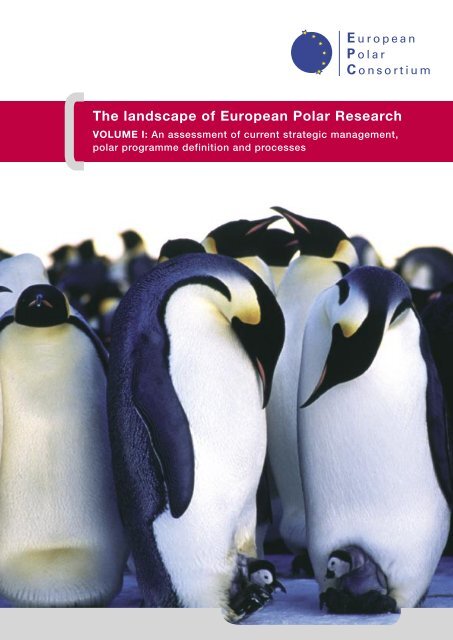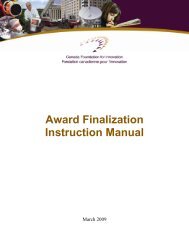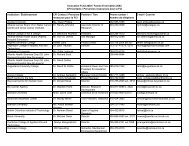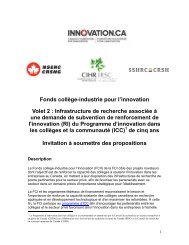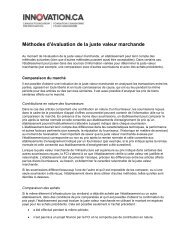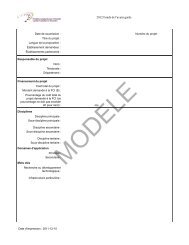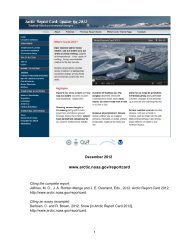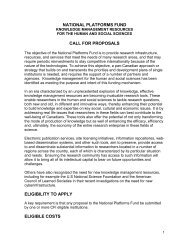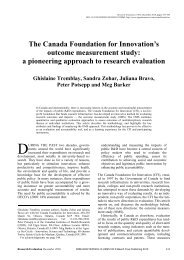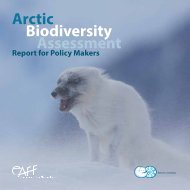The landscape of European Polar Research - European Science ...
The landscape of European Polar Research - European Science ...
The landscape of European Polar Research - European Science ...
Create successful ePaper yourself
Turn your PDF publications into a flip-book with our unique Google optimized e-Paper software.
<strong>The</strong> <strong>landscape</strong> <strong>of</strong> <strong>European</strong> <strong>Polar</strong> <strong>Research</strong><br />
VOLUME I: An assessment <strong>of</strong> current strategic management,<br />
polar programme definition and processes
<strong>The</strong> <strong>European</strong> <strong>Polar</strong> Consortium (EPC) is a Coordination Action financed by the <strong>European</strong><br />
Commission under framework RTD programme 6 EUROPOLAR ERA-NET ERAC 517842.<br />
<strong>The</strong> <strong>European</strong> <strong>Polar</strong> Consortium is a composed <strong>of</strong> 27 government ministries, national funding<br />
agencies and national polar RTD authorities from 19 <strong>European</strong> countries and <strong>of</strong> the <strong>European</strong><br />
<strong>Science</strong> Foundation/<strong>European</strong> <strong>Polar</strong> Board.<br />
With the combined <strong>European</strong> critical mass <strong>of</strong> national programmes reaching approximatively<br />
€ 300 million per annum, it is the most significant initiative to coordinate <strong>European</strong> polar RTD<br />
programmes ever attempted. <strong>The</strong> <strong>European</strong> <strong>Polar</strong> Consortium will exert a massive and positive impact<br />
on this domain and lead to long-term durable partnerships within Europe and internationally and will<br />
also deepen and strengthen the interactions between countries with large polar RTD programmes<br />
and nations with evolving polar programmes in central and south-eastern Europe, encouraging<br />
exchange <strong>of</strong> experiences and the best practice on management and financing <strong>of</strong> programmes and<br />
infrastructures.<br />
<strong>The</strong> long-term goal <strong>of</strong> the <strong>European</strong> <strong>Polar</strong> Consortium is the development <strong>of</strong> a «<strong>European</strong> <strong>Polar</strong><br />
Entity» that will be established through dialogue on a political level beyond the EPC and will enable<br />
Europe to maximize and direct its critical mass at the global level.<br />
<strong>The</strong> EUROPOLAR project partners are:<br />
• Institut Polaire Français Paul Emile Victor (IPEV) – France<br />
• <strong>European</strong> <strong>Polar</strong> Board – <strong>European</strong> <strong>Science</strong> Foundation (ESF)<br />
• Fonds zur Förderung der Wissenschaftlichen Forschung (FWF) – Austria<br />
• Fonds de la Recherche Scientifique (FNRS) – Belgium<br />
• <strong>Research</strong> Foundation - Flanders (FWO) – Belgium<br />
• Belgian <strong>Science</strong> Policy (BELSPO) – Belgium<br />
• Ministry <strong>of</strong> Foreign Affairs (MFA) – Bulgaria<br />
• Bulgarian Antarctic Institute (BAI) – Bulgaria<br />
• Ministry <strong>of</strong> Education, Youth and Sports (MSMT) – Czech Republic<br />
• Danish <strong>Polar</strong> Center (DPC) – Denmark<br />
• Danish Agency for <strong>Science</strong>, Technology and Innovation (DASTI) – Denmark<br />
• Estonian <strong>Science</strong> Foundation (ETF) – Estonia<br />
• Ministry <strong>of</strong> Transport and Communications (MITOC) – Finland<br />
• Alfred Wegener Institute for <strong>Polar</strong> and Marine <strong>Research</strong>-in the Helmholtz Association (AWI) – Germany<br />
• Federal Ministry <strong>of</strong> Education and <strong>Research</strong> (BMBF) – Germany<br />
• Department <strong>of</strong> Culture, Education, Youth and Church (KIIP) – Greenland<br />
• Ministry <strong>of</strong> Universities and <strong>Research</strong> (MUR) – Italy<br />
• Netherlands Organisation for Scientific <strong>Research</strong> (NWO) – Netherlands<br />
• <strong>The</strong> <strong>Research</strong> Council <strong>of</strong> Norway (RCN) – Norway<br />
• Norwegian <strong>Polar</strong> Institute (NPI) – Norway<br />
• Ministry <strong>of</strong> <strong>Science</strong> and Higher Education (MSHE) – Poland<br />
• Institute <strong>of</strong> Geophysics - Polish Academy <strong>of</strong> <strong>Science</strong>s (IGF-PAN) – Poland<br />
• Arctic and Antarctic <strong>Research</strong> Institute (AARI) – Russian Federation<br />
• Ministry <strong>of</strong> Education and <strong>Science</strong> (MEDC) – Romania<br />
• Ministry <strong>of</strong> Education and <strong>Science</strong> (MEC) – Spain<br />
• Swedish <strong>Research</strong> Council (VR) – Sweden<br />
• Natural Environment <strong>Research</strong> Council (NERC) – United Kingdom<br />
For further information on the <strong>European</strong> <strong>Polar</strong> Consortium please see: http://europolar.esf.org/<br />
03
Introduction<br />
This report summarises the current status <strong>of</strong> strategic processes, management practices, investment,<br />
evaluation and granting procedures <strong>of</strong> the 27 government agencies (19 countries) that are partners in<br />
the <strong>European</strong> <strong>Polar</strong> Consortium an ERA-NET funded under Framework Programme 6 by the <strong>European</strong><br />
Commission. Its conclusions are based on the most comprehensive analysis ever carried out <strong>of</strong> funding<br />
agencies and ministries who manage and own polar research programmes, infrastructures and activities in<br />
Europe. <strong>The</strong> report proposes a number <strong>of</strong> strategic questions and recommendations for the development<br />
<strong>of</strong> polar research programmes in Europe in the context <strong>of</strong> the <strong>European</strong> research area and indicates the<br />
possibilities for new approaches to developing <strong>European</strong> cooperation.<br />
This analysis <strong>of</strong> the practices <strong>of</strong> the major polar research funding agencies covered the following important<br />
issues.<br />
• Identification <strong>of</strong> the current status <strong>of</strong> <strong>European</strong> polar programmes, including strategic areas, investment<br />
strategies, administrative practices and identification <strong>of</strong> <strong>European</strong> capabilities and leadership.<br />
• <strong>The</strong> acquisition <strong>of</strong> a complete overview <strong>of</strong> all relevant polar programme elements and activities in Europe.<br />
• Definition <strong>of</strong> implementation guidelines and funding for the necessary polar RTD activities harmonised in<br />
a coherent and co-coordinated way.<br />
• <strong>The</strong> acquisition <strong>of</strong> a complete overview <strong>of</strong> <strong>European</strong> polar infrastructures (detailed in volume II <strong>of</strong> this report).<br />
<strong>The</strong> results <strong>of</strong> this assessment report <strong>of</strong> research programmes (volume I) and infrastructural capacity<br />
(volume II) will be used to identify issues <strong>of</strong> common priority and to actively develop trans-national activities<br />
including the launch <strong>of</strong> joint calls for proposals in a small number <strong>of</strong> strategic test cases. A core element <strong>of</strong><br />
this report is the construction <strong>of</strong> an idealised model for a <strong>European</strong> polar framework programme and the<br />
essential characteristics that it should be composed to add value and benefit to national efforts and ensure<br />
cost effective and high quality scientific outputs for the decades to come.<br />
<strong>The</strong> analysis compiled across the 19 countries and the trends that are identified provide a basis for the<br />
proposal <strong>of</strong> this idealised model. This model does not represent any specific existing programme, but it<br />
introduces the concept <strong>of</strong> programme convergence and harmonisation <strong>of</strong> processes at a <strong>European</strong> level<br />
that will be the subject <strong>of</strong> deeper analysis.<br />
Dr Gérard Jugie<br />
Chairman<br />
<strong>European</strong> <strong>Polar</strong> Consortium<br />
Dr Paul Egerton<br />
Executive Director<br />
<strong>European</strong> <strong>Polar</strong> Consortium<br />
04
Objectives<br />
<strong>The</strong> objectives <strong>of</strong> this analysis were to identify and characterise critical elements for deepening the<br />
collaboration between <strong>European</strong> polar research agencies, harmonising management processes and to<br />
strengthen <strong>European</strong> polar coordination in a global context. To obtain this result, an extensive platform<br />
<strong>of</strong> information was needed to highlight the current <strong>European</strong> strengths and weaknesses and to develop<br />
strategies and suitable instruments for future planning. It can thereby increase the possibilities for new<br />
collaborations, strategic activities and exchange <strong>of</strong> infrastructure elements and also provide an overview<br />
<strong>of</strong> the future needs in the RTD <strong>landscape</strong>. Multinational and interconnected long-term planning between<br />
<strong>European</strong> countries is potentially very powerful and will significantly contribute to establish collaborative<br />
programmes and policies. <strong>The</strong> main strategic conclusions are presented in this report.<br />
Contents<br />
<strong>Polar</strong> programme ownership, strategy<br />
and geopolitical drivers p. 06<br />
Overview <strong>of</strong> <strong>European</strong> investment in research<br />
programmes in <strong>Polar</strong> Regions p. 09<br />
Legal frameworks and collaborative agreements<br />
covering <strong>Polar</strong> Regions p. 11<br />
<strong>Research</strong> granting processes p. 13<br />
Specificities and geographical aspects <strong>of</strong> polar<br />
research programmes p. 16<br />
Common scientific priorities within<br />
the <strong>European</strong> <strong>Polar</strong> RTD <strong>landscape</strong> p. 18<br />
Concluding remarks and recommendations p. 25<br />
05
1. <strong>Polar</strong> programme ownership,<br />
strategy and geopolitical drivers<br />
In the <strong>European</strong> context, it is important to highlight that there are many bodies and agencies involved or<br />
contributing to the «national polar activity», and that communication between these bodies was essential<br />
to obtaining an accurate picture <strong>of</strong> the national <strong>landscape</strong>. <strong>The</strong> bodies managing research programmes<br />
are diverse and many <strong>of</strong> them are organised under general umbrellas <strong>of</strong> environmental research. However,<br />
there are significant exceptions to this trend with some countries having strong geopolitical interest for their<br />
presence in the <strong>Polar</strong> Regions. <strong>The</strong>se different behaviours determine a diversity <strong>of</strong> funding sources and<br />
implementation mechanisms that constitute a stimulating area for the development <strong>of</strong> common procedures<br />
or systems.<br />
STRATEGIC QUESTIONS<br />
<strong>The</strong>re is a high diversity <strong>of</strong> organisations that manage and fund research in the <strong>Polar</strong><br />
Regions in Europe. A key challenge in the overall system is that management strategies<br />
are not sufficiently harmonised. Can a future framework be proposed which enables<br />
long term connected planning and an enhanced approach to internal and external<br />
coordination?<br />
<strong>The</strong> majority <strong>of</strong> <strong>European</strong> agencies that were analysed indicated that their national polar research is based<br />
on a formalised strategic plan and these are <strong>of</strong>ten combined with other research and implementation plans.<br />
Many <strong>of</strong> the planning documents cover both <strong>Polar</strong> Regions. <strong>The</strong> most common time spans for the strategy<br />
plan is between three to four years. It is apparent from the data that strategies in relation to the Antarctic<br />
region are more developed at a <strong>European</strong> level perhaps pointing to the existence <strong>of</strong> a formalised structure<br />
(the Antarctic Treaty and related bodies such as SCAR and COMNAP) which requires parties to carry out<br />
national programmes and formally exchange information on their scientific and strategic activities. <strong>The</strong><br />
Arctic region currently lacks the same degree <strong>of</strong> formal agreement and only a limited number <strong>of</strong> countries<br />
develop Arctic strategies. This can be explained by their direct interest in the Arctic territory and to fulfil<br />
political requirements (e.g. the Arctic Council). In the case where countries developed bipolar strategies<br />
these generally have very well developed and financed polar activity, which allow inter-comparison between<br />
their research activities in both <strong>Polar</strong> Regions.<br />
Drivers to developing a national strategy<br />
When defining national strategies it is <strong>of</strong>ten a combination <strong>of</strong> scientific and political considerations, which<br />
define investments, there characteristics, and the priorities <strong>of</strong> such strategies. <strong>The</strong> definition <strong>of</strong> a national<br />
strategy also has to take into account external global issues that enter into the policy arena through<br />
ministries, especially in relation to foreign affairs, environment and defence. <strong>The</strong> issue <strong>of</strong> climate change has<br />
now broad geopolitical and economic considerations and therefore a large number <strong>of</strong> the countries publish<br />
their plans in public encouraging the sharing and communication <strong>of</strong> polar research priorities between<br />
countries. Many countries have a variety <strong>of</strong> agencies and ministries that produce comprehensive strategy<br />
plans that includes polar elements. <strong>The</strong>re is a trend for moving towards a greater inter-agency cooperation<br />
in polar research within the country. <strong>The</strong> harmonisation <strong>of</strong> strategic plans in Europe may help to simplify<br />
and streamline the negotiation process with international partners, especially in programmes which require<br />
multinational engagements and strategic investments.<br />
06
STRATEGIC QUESTIONS<br />
Could elements from these strategic plans be assembled into common <strong>European</strong><br />
priorities so that they could produce added value in the international context?<br />
Geopolitical aspects in polar research have some important relevance, especially in relation to the Antarctic<br />
Treaty or to the Arctic Council.<br />
For the Arctic, geopolitical aspects are related to the geographical settings <strong>of</strong> the nations. <strong>The</strong> Arctic<br />
is increasingly becoming an arena for diplomatic discussions for energy, hydrocarbon and territorial<br />
delimitation. In this respect the following examples can be stressed:<br />
• <strong>The</strong> Svalbard treaty.<br />
• <strong>The</strong> Northern Sea route and the North East passage, which has connections with commercial traffic<br />
through to the Pacific. Increased exploration and transportation <strong>of</strong> hydrocarbon in the Arctic which would<br />
have consequences on environmental legislation.<br />
For the Antarctic the regulation <strong>of</strong> the Antarctic Treaty System:<br />
• ongoing issues related to environmental protection<br />
• fisheries and conservation <strong>of</strong> marine living resources<br />
• application <strong>of</strong> the law <strong>of</strong> the sea and specificities related to the Antarctic Treaty System.<br />
STRATEGIC QUESTIONS<br />
<strong>The</strong> existence <strong>of</strong> national strategy plans for polar research in the individual countries is<br />
encouraging. Is it possible to propose mechanisms to identify overall <strong>European</strong> common<br />
priorities and strategies in the <strong>Polar</strong> Regions and roadmaps to the efficient financing<br />
and implementation <strong>of</strong> trans-national programmes?<br />
07
2. Overview <strong>of</strong> <strong>European</strong><br />
investment in research<br />
programmes in <strong>Polar</strong> Regions<br />
This is the first analysis <strong>of</strong> research investments by <strong>European</strong> nations in the <strong>Polar</strong> Regions and is a critical<br />
important component when considering any future co-operation. It is necessarily very difficult to obtain<br />
accurate figures on total research and asset investment. However, a baseline has been established to<br />
facilitate information exchange between funding agencies/programme managers to build a mutual trust<br />
and knowledge for planning.<br />
<strong>The</strong> survey among the 27 partners gave an estimate <strong>of</strong> slightly less than € 300 million for the total national<br />
annual investment in polar research by the 19 consortium countries. This includes management <strong>of</strong> polar<br />
research activities, infrastructures, project grants and outreach activities. <strong>The</strong> funding by the individual<br />
countries has a very broad range depending upon the magnitude <strong>of</strong> the programme. Several large<br />
countries have high investment in research programmes and especially infrastructures (> € 25 million),<br />
with a maximum per individual country <strong>of</strong> € 70 million, whilst a cluster <strong>of</strong> countries have lower investments<br />
(significantly less than the average <strong>of</strong> € 15 million).<br />
General percentage breakdown <strong>of</strong> EPC partners investment<br />
in polar research programmes and infrastructures per year<br />
(Approx. amount used for…)<br />
monitoring<br />
public outreach<br />
and education<br />
3%<br />
1%<br />
18%<br />
personnel / staff<br />
science<br />
30%<br />
48%<br />
logistics<br />
<strong>The</strong> infrastructure (logistics and monitoring) totals on average € 120 million per annum, project grants<br />
to approximately € 70 million, polar research management € 41 million, education and outreach to<br />
approximately € 2.5 million. Comments by the agencies Other providing the data suggest that the way in which<br />
the agencies allocate funding is not<br />
Databases<br />
uniform and requires deeper General investigation policy to determine the sources<br />
4%<br />
and processes that control national investment 9% pr<strong>of</strong>iles. It 16% is interesting to note that the total combined<br />
annual investment for <strong>European</strong> countries is <strong>of</strong> the same magnitude <strong>of</strong> countries such as the United<br />
States. <strong>The</strong> International <strong>Polar</strong> Year has had a marked effect on the polar research investment pr<strong>of</strong>iles <strong>of</strong><br />
Logistics 19%<br />
selected <strong>European</strong> countries and sharing which have important geopolitical 18% drivers Mutual for support such injection <strong>of</strong> funding at<br />
international programme level.<br />
Facility<br />
sharing<br />
18%<br />
16%<br />
Coordination<br />
09 9
<strong>The</strong> diversity <strong>of</strong> polar financing models<br />
<strong>The</strong> funding mechanisms vary between two extremes. In one case all funding is directed though specific<br />
polar research programme within a ministry, agency or institute and at the other end <strong>of</strong> the spectrum<br />
funding is granted through research funding agencies on a competitive project basis. <strong>The</strong> most common<br />
is an intermediate financing model where institutes or agencies provide research funding and sometimes<br />
also infrastructure, and these resources are integrated by additional funds for research projects coming<br />
from research funding agencies.<br />
This model reflects a more complex model <strong>of</strong> inter-agency cooperation. Based on the survey data, the large<br />
countries with more developed programmes have a more complex financing system. Experience from these<br />
systems can be transferred to those countries only recently developing their polar programme activities.<br />
A majority <strong>of</strong> the countries provide research funding over a period <strong>of</strong> three or more years (multi-annual)<br />
and that allocation <strong>of</strong> funds <strong>of</strong>ten can be extended when needed. Legislation and policies on transferring<br />
funding to other countries differs within the Europolar consortium partner countries have been analysed.<br />
Eight <strong>of</strong> the countries report the funding to be essentially national, which means that it can be awarded only<br />
to the countries citizens. Funding can follow researchers abroad only in nine <strong>of</strong> the consortium countries.<br />
Actual transfer <strong>of</strong> funds to support research in another country is only possible for six <strong>of</strong> the consortium<br />
countries. This type <strong>of</strong> situation is reflected at a general level within the <strong>European</strong> research area. <strong>The</strong><br />
issue <strong>of</strong> direct transfer <strong>of</strong> funding across borders is being actively debated at the present time in the<br />
<strong>European</strong> research area, and has complex legal implications. An example <strong>of</strong> transnational funding model<br />
is the EPICA programme (1996-2006, <strong>European</strong> Project for Ice Coring in Antarctica), where ten countries<br />
pooled funding together for deep ice coring the Antarctic plateau. It provided coordination for deep drilling<br />
activities at Dome C Concordia and Kohnen Station, which was supported by the <strong>European</strong> Commission<br />
Framework Programme, the <strong>European</strong> <strong>Science</strong> Foundation and significant national contributions from<br />
Belgium, Denmark, France, Germany, Italy, the Netherlands, Norway, Sweden, Switzerland and the United<br />
Kingdom. Such a successful model should be envisaged for other scientific domains. <strong>The</strong> development <strong>of</strong><br />
a framework for coordinating funding for research calls in polar research is an innovative way forward to<br />
build financial and scientific commitment across the different <strong>European</strong> countries.<br />
STRATEGIC QUESTIONS<br />
<strong>The</strong> assessment indicates that direct financing models for research in <strong>Polar</strong> Regions<br />
are complex. <strong>The</strong>re are a multitude <strong>of</strong> systems operating in the current polar RTD<br />
<strong>landscape</strong>. Can an efficient and streamlined mechanism be developed to enable the<br />
financing <strong>of</strong> multinational programmes?<br />
Can a mechanism be identified which links together strategic and purely competitive<br />
systems to construct multinational programmes at a <strong>European</strong> level?<br />
10
3. Legal frameworks and<br />
collaborative agreements<br />
covering <strong>Polar</strong> Regions<br />
<strong>The</strong> majority <strong>of</strong> national polar programmes (61%) require certain types <strong>of</strong> activities to comply with specific<br />
legislation. <strong>The</strong> legislation refers to limitations on scientific sampling, invasive monitoring activity, logistics<br />
and operation, social science, ethics and other aspects. Countries carrying out research in Antarctica are<br />
committed to make it in compliance with the Madrid Protocol on Environmental Protection to the Antarctic<br />
Treaty. It requires action that must be regulated at a national level by the legislation <strong>of</strong> each country that<br />
ratified the treaty. In order to integrate more easily the polar activities <strong>of</strong> the <strong>European</strong> countries, an uniform<br />
legislation at <strong>European</strong> level for the application <strong>of</strong> the Protocol <strong>of</strong> Madrid could be favourable.<br />
STRATEGIC QUESTIONS<br />
National regulations and legislation is applicable in relation to obligations under the<br />
Antarctic Treaty System. As <strong>European</strong> countries adopt common positions is there a<br />
need to assess the applicability <strong>of</strong> <strong>European</strong> legislation in the <strong>Polar</strong> Regions?<br />
Official cooperative agreements and collaboration on common research<br />
programmes<br />
monitoring<br />
public outreach<br />
and education<br />
Memoranda <strong>of</strong> understanding (MoU) represent the 3% current internal personnel or external / staff cooperation agreements.<br />
1%<br />
<strong>The</strong>y are important as a basis for building common <strong>European</strong> 18% approaches in cooperative agreements<br />
because they provide the description <strong>of</strong> national relationship system that could be expanded into a higher<br />
science<br />
30%<br />
level <strong>of</strong> multilateral cooperation. <strong>The</strong> majority <strong>of</strong> the 19 consortium countries (83,33%) declared to have<br />
memoranda <strong>of</strong> understanding. <strong>The</strong> countries which do not currently have MoUs are those which have<br />
very new programmes and still need to establish the basis for logistical or scientific cooperation with other<br />
<strong>European</strong> countries or international partners.<br />
This underlines that the memoranda <strong>of</strong> understanding are basic building blocks <strong>of</strong> cooperative polar<br />
48%<br />
activities, which requires wide relationships with other logistic logistics and scientific bodies at national and<br />
international level. <strong>The</strong> main areas covered by such existing agreements are general policy, mutual support,<br />
databases, logistics sharing, coordination and facility sharing. <strong>The</strong> statistics indicated that general policy,<br />
databases and facility sharing could be areas for expansion.<br />
Percentage <strong>of</strong> MoUs per activity areas<br />
Other<br />
Databases<br />
9%<br />
4%<br />
16%<br />
General policy<br />
Logistics<br />
sharing<br />
19%<br />
18%<br />
Mutual support<br />
18%<br />
16%<br />
Facility<br />
sharing<br />
Coordination<br />
11
<strong>The</strong> most common time-span for a MoU is three to five years and the MoU covers equally Arctic and<br />
Antarctic regions. <strong>The</strong>se agreements are <strong>of</strong>ten linked to the programme cycle, however longer-term<br />
cooperation agreements exist for strategic purposes cross-cutting the programme cycle. Generally<br />
speaking, a memorandum <strong>of</strong> understanding is expected to have a confidential nature. <strong>The</strong> analysis <strong>of</strong><br />
the agencies indicate that currently are not favourable to make information easily accessible as they may<br />
contain elements <strong>of</strong> bilateral issues.<br />
<strong>The</strong> agreements that can be commonly found on the Internet are those international and very comprehensive<br />
(i.e <strong>The</strong> Antarctic Treaty System’s Conventions, the Madrid Protocol on Environmental Protection to the<br />
Antarctic Treaty). At <strong>European</strong> level this kind <strong>of</strong> multilateral agreements for polar research are still rare, while<br />
there are already <strong>of</strong>ficial cooperative bilateral agreements on a national basis.<br />
STRATEGIC QUESTIONS<br />
<strong>The</strong> existence <strong>of</strong> <strong>of</strong>ficial cooperative agreements in the <strong>Polar</strong> Regions are dominated<br />
at the present time by logistical and asset support on a bilateral basis. Is there a need<br />
in the future to develop firm agreements on a multi-lateral basis on areas <strong>of</strong> common<br />
research planning and prioritisation <strong>of</strong> themes?<br />
Several stations in Antarctica and in the Arctic are operated as common platforms supporting research<br />
programmes with shared objectives – both in Europe and with other partners worldwide. Joint stations with<br />
only <strong>European</strong> partners are Samoylov (Germany and Russia), AWIPEV (France and Germany), Ny-Ålesund<br />
Marine Laboratory (Norway and other nations) and Eiscat (Sweden, Finland, Norway, China, France,<br />
Germany and others) in the Arctic and Concordia (Italy and France) and Wasa (Sweden and Finland) in<br />
Antarctica.<br />
Stations which are jointly managed between a <strong>European</strong> country and other international partners are<br />
Dallmann Laboratory (Germany and Argentina), GARS-O’Higgins (Germany and Chile) and Law-Racovita<br />
(Australia and Romania), all <strong>of</strong> them in Antarctica. An additional example <strong>of</strong> previous <strong>European</strong> multilateral<br />
cooperation in polar science infrastructure is the <strong>European</strong> Economic Interest Group “Geophysica”, which<br />
provides the strategy, the technical feasibility, the coordination and the field operations for stratospheric<br />
research based on the Russian M55 Geophysica aircraft. <strong>The</strong> analysis <strong>of</strong> the agencies indicates that for<br />
the future there is a great value <strong>of</strong> constructing cooperative agreements to enhance polar research and<br />
operations. <strong>The</strong>re is a need to explore future partnerships which connect Europe and international partners<br />
on areas <strong>of</strong> mutual interest.<br />
STRATEGIC QUESTIONS<br />
Should there be a consideration <strong>of</strong> harmonisation and efficiency by putting in place<br />
mechanisms for reciprocal opening and sharing <strong>of</strong> facilities in the <strong>Polar</strong> Regions?<br />
12
4. <strong>Research</strong> granting<br />
processes<br />
<strong>The</strong>re are large differences when it comes to the granting processes for polar research programmes in<br />
Europe and the three steps <strong>of</strong> submitting, evaluating and implementation. Almost all agencies (83%) require<br />
to complete a special form (paper and/or electronic version with a range <strong>of</strong> 1-26 pages) which is most<br />
commonly in English and/or bilingual. <strong>The</strong> 2/3 <strong>of</strong> the partners who answered the questionnaire require to<br />
separate the budgets for science and logistics. Half <strong>of</strong> the partners have a national operator who provides<br />
logistic support to the projects basing on a specific budget. In many cases the logistic operator evaluates<br />
the operational costs.<br />
Ethical issues<br />
Regarding ethical issues, in the pre-submission phase a sum <strong>of</strong> ten partners answers that they do require<br />
special procedures, but they are based on very different rules and sources, such as national legislation,<br />
international agreements or declaration, internal guidelines. Ethical committees are <strong>of</strong>ten also actively<br />
involved. <strong>The</strong> 38% <strong>of</strong> these regulations are published by some means (half <strong>of</strong> them on the Internet).<br />
<strong>The</strong> countries which do not require special procedures for ethical issues do not have a clear common<br />
background. A trend towards an extending <strong>of</strong> procedures to manage ethical issues could be expected in<br />
the future.<br />
STRATEGIC QUESTIONS<br />
Extension <strong>of</strong> ethical issues is expected into polar science management, should there<br />
be a consideration <strong>of</strong> harmonisation looking for a common <strong>European</strong> Ethical Chart that<br />
could be agreed as common minimum level by <strong>European</strong> countries?<br />
Dissemination, administration and selection<br />
A significant number <strong>of</strong> consortium countries (70%) have a pre-qualification round for the proposals, using<br />
procedures similar to the expressions <strong>of</strong> interest. <strong>The</strong> majority <strong>of</strong> the polar programmes (55%) diffuse the<br />
information throughout Internet, downloadable from a web site. In general, the proposals are stored in<br />
databases but they are not accessible by the public. <strong>The</strong> proposals are then evaluated by reviewers. <strong>The</strong><br />
most common evaluation system is a competitive process based on a peer review panel. In several cases<br />
there are variants to this scheme, where the evaluation process looks even more comprehensive including<br />
a State Committee or/and and Administrative Committee in addition to the peer review panel. In two cases<br />
only, an Administrative Commission is appointed for reviewing the proposals.<br />
13
<strong>The</strong> evaluation process takes different time periods between the <strong>European</strong> partners. It varies between four<br />
weeks up to eight months, with the most common time <strong>of</strong> twelve weeks.<br />
Applicants receive the decisions usually by postal letter or, in few countries, by email. In addition, the<br />
management <strong>of</strong> the successful proposals follows different path to be publicised. A small number <strong>of</strong><br />
<strong>European</strong> countries run multi-year statistics on the polar programme proposals in addition these countries<br />
list the proposals into an executive plan or into an annual report.<br />
Funding awards and post-award reporting<br />
<strong>The</strong> time-span for the transfer <strong>of</strong> funding varies from days to months - both comparing the countries<br />
and within the country itself. <strong>The</strong> most common is the electronic transfer but also other ways <strong>of</strong> transfer<br />
takes place, like bank cheques and wires. <strong>The</strong> actual transfer mechanisms seem to be well accepted by<br />
all the partners, since none considers that a change is needed. <strong>The</strong> great majority <strong>of</strong> funding agencies<br />
pay special attention to activity report and tracking results. <strong>The</strong> kind <strong>of</strong> written feedback that is generally<br />
required is an activity progress report to funding agencies and programme management, a final activity<br />
report to funding agency and the published peer-reviewed publications resulting from the funded activity.<br />
Reports to administrations and logistic services seem to be less important. This result shows that generally<br />
national <strong>European</strong> polar programmes have a strong scientific orientation, and that logistics is viewed as a<br />
fundamental tool to achieve the scientific objectives <strong>of</strong> the national programmes and strategies.<br />
STRATEGIC QUESTIONS<br />
Even though the administrative procedures for polar programmes granting and transfer<br />
<strong>of</strong> funds to successful applicants are very diverse among the 19 countries, a strong<br />
attention to formal management procedures and scientific results control is evident.<br />
Is it possible to develop a roadmap towards common procedures on funding<br />
management and reporting <strong>of</strong> results at the <strong>European</strong> level ?<br />
<strong>Polar</strong> programme outreach activities and participation<br />
in the International <strong>Polar</strong> Year<br />
A significant number <strong>of</strong> consortium countries (67%) national programmes carry out outreach activities at a<br />
political level and also to the public, media and governmental institutions. This is an increasingly important<br />
activity in programmes such as the International <strong>Polar</strong> Year, where education, outreach and communication<br />
are vital elements. <strong>European</strong> countries have been actively involved in leading outreach to the public and it is<br />
viewed as critical for explaining how investments are used in an efficient, justifiable and transparent way.<br />
14
5. Specificities and geographical<br />
aspects <strong>of</strong> polar research<br />
programmes<br />
Arctic research<br />
<strong>The</strong> Arctic is a key region for scientific research. A significant portion <strong>of</strong> the Arctic area lies within the territory<br />
<strong>of</strong> <strong>European</strong> countries and therefore it has a natural and very close connection to the <strong>European</strong> scientific<br />
community. <strong>The</strong> Arctic countries (Denmark, Iceland, Finland, Greenland, Norway, Russia and Sweden) have<br />
stronger national strategic interest in conducting scientific activity in these regions. An increasing number<br />
<strong>of</strong> other <strong>European</strong> countries are carrying out Arctic research programmes.<br />
In 1991 eight Arctic countries (including Canada and the United States) approved the «Arctic Environmental<br />
Protection Strategy» (AEPS) with the aim to improve the understanding <strong>of</strong> the critical environmental issues<br />
and the implications to the inhabitants <strong>of</strong> the Arctic and its surroundings. Five years later, in 1996, Foreign<br />
Ministers <strong>of</strong> those Arctic states agreed to form the Arctic Council with a mandate to undertake a broad<br />
programme to include all dimensions <strong>of</strong> sustainable development. <strong>The</strong> Arctic Council is a high-level<br />
intergovernmental forum. <strong>The</strong> core members are Canada, Denmark, Finland, Iceland, Norway, Russian<br />
Federation, Sweden, and the United States <strong>of</strong> America. Europe has a great regional interest for the Arctic<br />
since it is a crucial area for climate change studies as well as environmental, social, and industrial policies.<br />
<strong>The</strong> International Arctic <strong>Science</strong> Committee (IASC), the non-governmental organisation established in 1990<br />
for facilitating cooperation in all aspects <strong>of</strong> arctic research, comprises now eighteen members, thirteen <strong>of</strong><br />
which are <strong>European</strong> (including Russia). On behalf <strong>of</strong> the Arctic Council and the International Arctic <strong>Science</strong><br />
Committee (IASC), an international project (ACIA the Arctic Climate Impact Assessment) whose purpose<br />
was to evaluate and synthesise knowledge on climate variability, climate change, and increased ultraviolet<br />
radiation and their consequences was launched. <strong>The</strong> results <strong>of</strong> the assessment were released in Reykjavik,<br />
Iceland in November 2004.<br />
Currently the main current studies <strong>of</strong> the <strong>European</strong> countries focus on quantifying the role <strong>of</strong> the Arctic in<br />
global climate; predicting and monitoring changes in Arctic environment and ecosystems, developing new<br />
technologies and improving human and social health.<br />
In recent years many joint <strong>European</strong> and international programmes have been launched. Examples <strong>of</strong><br />
specific large-scale research collaborations supported by the <strong>European</strong> Commission in the Arctic are<br />
DAMOCLES, IPY-CARE, GRIP, ENVINET.<br />
DAMOCLES is an integrated ice-atmosphere-ocean monitoring and forecasting system funded by the<br />
<strong>European</strong> Union under the 6 th Framework Programme, designed for observing, understanding and<br />
quantifying climate changes in the Arctic.<br />
<strong>The</strong> overall objective <strong>of</strong> IPY-CARE, funded by the <strong>European</strong> Commission (International <strong>Polar</strong> Year - Climate<br />
<strong>of</strong> the Arctic and its Role for Europe) is to create, co-ordinate and prepare a pan-<strong>European</strong> science and<br />
implementation plan for Arctic climate change and ecosystems research programme as contribution to the<br />
International <strong>Polar</strong> Year. IPY-CARE is an endorsed project by the IPY Joint Committee with more than 66<br />
partners from many different countries.<br />
GRIP: within the framework <strong>of</strong> the joint <strong>European</strong> Greenland Ice Core Project (GRIP), supported by the<br />
<strong>European</strong> <strong>Science</strong> Foundation and national commitments, a 3029m long ice core was drilled in Central<br />
Greenland from 1989 to 1992 at 72o 35’ N, 37o 38’ W.<br />
16
<strong>The</strong> objective <strong>of</strong> the GRIP effort was to reveal the broad spectrum <strong>of</strong> information on past environmental,<br />
and particularly climatic, signal that are stored in the ice. This information will help investigators understand<br />
the major mechanisms <strong>of</strong> the earth and man’s potential impact.<br />
ENVINET constituted a network <strong>of</strong> <strong>European</strong> polar and alpine infrastructures focusing on multidisciplinary<br />
environmental research in Northern Europe. <strong>The</strong> network involved 17 research stations from the <strong>European</strong><br />
Alps to the Arctic. Each station participated with representatives from its operator and their scientific users.<br />
<strong>The</strong> participating stations covered a broad range <strong>of</strong> environmental sciences, primarily within atmospheric<br />
physics and chemistry, and marine and terrestrial biology.<br />
Antarctic research<br />
<strong>The</strong> total number <strong>of</strong> the international Antarctic facilities is 65 (source : COMNAP). 28 <strong>of</strong> these are <strong>European</strong><br />
stations, including 7 Russian stations. <strong>The</strong> <strong>European</strong> stations are distributed all over the Antarctic and in<br />
most cases provide landing facilities which allow aerial connections. <strong>The</strong> <strong>European</strong> polar infrastructures<br />
also include over 30 polar vessels many <strong>of</strong> which are or could be used in Antarctica. A common appropriate<br />
use <strong>of</strong> these resources could overcome the cost <strong>of</strong> carrying out research in Antarctica, which is several<br />
times higher than in the Arctic due to the larger scale <strong>of</strong> infrastructural and logistical support required.<br />
<strong>The</strong>se integration potentials are not yet adequately exploited and the <strong>European</strong> countries act independently<br />
on the basis <strong>of</strong> specific scientific and logistic interests.<br />
Several large scientific projects, with <strong>European</strong> participation, are carried out in Antarctica; for example the<br />
research <strong>of</strong> climate history performed by deep core ice drilling, evolution and biodiversity programmes<br />
and studies by the inter-hemispheric interactions and space studies. EPICA, supported by the <strong>European</strong><br />
Commission, the <strong>European</strong> <strong>Science</strong> Foundation and national contributions, was a multinational <strong>European</strong><br />
project for deep ice core drilling in Antarctica. Its main objective was to obtain full documentation <strong>of</strong><br />
the climatic and atmospheric record archived in Antarctic ice. Evaluation <strong>of</strong> these records are providing<br />
information about the natural climate variability and mechanisms <strong>of</strong> rapid climatic changes during the<br />
last glacial epoch. This was a well coordinated effort to pool and connect resources to obtain maximum<br />
scientific and political impact.<br />
Deep drilling has taken place at two sites in Antarctica: Concordia station, Dome C (coordinates 75°06’S;<br />
123°21’E, 3233m above sea level) and Kohnen station, Dronning Maud Land (coordinates 75°00’S;<br />
00°04’E, 2892m above sea level).<br />
<strong>The</strong> Antarctic Muon And Neutrino Detector Array (AMANDA) was the largest currently operational detector<br />
for studying neutrinos. It consisted <strong>of</strong> 19 «strings» <strong>of</strong> optical detectors connected to cables buried between<br />
1500m and 2000m below the surface <strong>of</strong> the South Pole ice cap, with a total <strong>of</strong> 677 optical sensors.<br />
AMANDA is just the begining, though.<br />
Currently under construction at the US Amundsen Scott station at the South Pole is the massive IceCube<br />
detector. Like AMANDA, IceCube will consist <strong>of</strong> a series <strong>of</strong> strings buried in the ice. Both larger and<br />
more advanced than its predecessor, IceCube will greatly improve upon AMANDA’s potential for scientific<br />
discovery. Consisting <strong>of</strong> a total <strong>of</strong> approximately 5000 detectors and with a volume <strong>of</strong> a cubic kilometer,<br />
IceCube will monitor one billion tons <strong>of</strong> the Antarctic ice cap for traces <strong>of</strong> neutrinos.<br />
17
6. Common scientific priorities<br />
within the <strong>European</strong> <strong>Polar</strong> RTD<br />
<strong>landscape</strong><br />
<strong>The</strong> <strong>European</strong> agencies that were analysed across the 19 countries listed a total <strong>of</strong> 55 prioritised themes<br />
in research and / or topics within the national strategic plans. Whilst compiling the themes there was no<br />
ranking or indication <strong>of</strong> relative importance. <strong>The</strong>se themes have then also been clustered into basic / free<br />
research priorities and also thematic / strategic research priorities.<br />
Prioritised themes<br />
Arctic ecosystems and<br />
effects <strong>of</strong> climate change<br />
<strong>The</strong>matic / Strategic<br />
research priorities<br />
Arctic ecosystems and<br />
effects <strong>of</strong> climate change<br />
Basic / Free research<br />
priorities<br />
Astrophysics<br />
Arctic technology innovation Arctic technology innovation Atmospheric chemistry<br />
Astrophysics Climate and atmosphere Atmospheric physics<br />
Atmospheric chemistry<br />
Atmospheric physics<br />
Climate and environmental<br />
monitoring, long time-series<br />
Climate changes – natural<br />
and anthropogenic<br />
Biology<br />
Biodiversity Climate changes and their effects Geodesy<br />
Earth observatory<br />
Biology Climate dynamics (past, present and future) Geography<br />
Climate & atmosphere Climate research Geology<br />
Climate and environmental<br />
monitoring, long time-series<br />
Climate changes – natural<br />
and anthropo-genically induced<br />
Cultural encounters and<br />
globalisation<br />
Cultural History<br />
Geophysics<br />
Glaciology<br />
Climate changes and their effects Ecosystem monitoring Health and Nutrition<br />
Climate dynamics (past,present and future) Ecosystem research and biodiversity Human biology<br />
Climate research<br />
Effects <strong>of</strong> human activity on ecosystems<br />
and society<br />
Human health<br />
Cultural encounters and globalization Environment and Climate Juridical sciences<br />
Cultural History Living conditions Language<br />
Earth observatory<br />
Long-distance contamination<br />
<strong>of</strong> food chain<br />
Oceanography<br />
Ecosystem monitoring Marine & Terrestrial ecosystems Paleo research<br />
Ecosystem research and<br />
biodiversity<br />
Effects <strong>of</strong> human activity on<br />
ecosystems and society<br />
Environment and Climate<br />
Geodesy<br />
Geography<br />
Geology<br />
Geophysics<br />
Glaciology<br />
Health and Nutrition<br />
Human biology<br />
Human health<br />
Juridical sciences<br />
Language<br />
Living conditions<br />
Long-distance contamination<br />
<strong>of</strong> food chain<br />
Marine ecology<br />
Marine ecosystems - and<br />
the human dimension<br />
Marine resources and products<br />
Medicine<br />
Mineral resources<br />
Terrestrial ecosystems<br />
Natural Resources<br />
Non-renewable energy resources<br />
<strong>Polar</strong> environment chemistry<br />
<strong>Polar</strong> history<br />
Societal and juridical changes in the Arctic<br />
Renewable and nonrenewable resources<br />
Social Conditions<br />
Societal development<br />
Socio-economic development<br />
Sun-Earth interactions<br />
Technology<br />
18
monitoring<br />
public outreach<br />
and education<br />
3%<br />
1%<br />
18%<br />
personnel / staff<br />
science<br />
30%<br />
Prioritised themes<br />
<strong>The</strong>matic / Strategic<br />
research priorities<br />
Marine & Terrestrial ecosystems<br />
Technological developments<br />
Marine ecology<br />
Technology and living conditions<br />
Marine ecosystems - and the<br />
<strong>The</strong>matic monitoring and prospecting<br />
human dimension<br />
Marine resources and products<br />
48%<br />
logistics<br />
Medicine<br />
Mineral resources<br />
Terrestrial ecosystems<br />
Natural Resources<br />
Non-renewable energy resources<br />
Oceanography<br />
Other<br />
PaleoresearchDatabases<br />
General policy<br />
<strong>Polar</strong> environment chemistry 4%<br />
<strong>Polar</strong> history<br />
9%<br />
16%<br />
Societal and juridical changes<br />
in the Arctic<br />
Logistics 19%<br />
Renewable sharing and nonrenewable resources 18% Mutual support<br />
Social Conditions<br />
Societal development<br />
18%<br />
Socio-economic development 16%<br />
Facility<br />
Sun-Earth interactions<br />
sharing<br />
Coordination<br />
Technological developments<br />
Technology<br />
Technology and living conditions<br />
<strong>The</strong>matic monitoring and prospecting<br />
Basic / Free research<br />
priorities<br />
Oceanography<br />
Human<br />
studies<br />
Metereology,<br />
climate<br />
12%<br />
Legacy<br />
Space physics<br />
13%<br />
<strong>European</strong> expressions <strong>of</strong><br />
Biology<br />
interest – International <strong>Polar</strong><br />
7%<br />
20%<br />
Year 2007-2009 (IPY)<br />
9%<br />
This figure shows the distribution <strong>of</strong><br />
the expression <strong>of</strong> interest in IPY. <strong>The</strong><br />
18%<br />
Cryosphere distribution among the disciplines<br />
highlights the bottom to top priorities<br />
5% and capacities <strong>of</strong> the Europolar scientific<br />
1% 14% 1% Data<br />
management community in polar science.<br />
Geological<br />
Education<br />
Within the research stations in Antarctica the highest percentage <strong>of</strong> scientific activities focus on climate<br />
change research. Additionally geo-science studies are also numerous. Astrophysics/astronomy is a<br />
developing area for Europe that it requires high infrastructural investments. <strong>The</strong> recent increase <strong>of</strong> interest<br />
in astronomy in Antarctica is due to the discovery <strong>of</strong> unique observational conditions that can be found on<br />
the Antarctic plateau.<br />
19
ANTARCTIC STATIONS<br />
Ohridski<br />
Aboa<br />
Dallmann<br />
Gars<br />
Kohnen<br />
Neumayer<br />
Concordia<br />
Zucchelli<br />
Climatology, climate change • • • • • • • • • • • • • • • • • • • • • • 22<br />
Glaciology • • • • • • • • • • • • • • • • • • 18<br />
Geology and<br />
sedimentology • • • • • • • • • • • • • • • • • • 18<br />
Geophysics • • • • • • • • • • • • • • • • • 17<br />
Environ. sciences, pollution • • • • • • • • • • • • • • • • • 17<br />
Geodesy • • • • • • • • • • • • • • • 15<br />
Atmospheric chemistry<br />
& physics • • • • • • • • • • • • • • • 15<br />
Terrestrial biology, ecology • • • • • • • • • • • • • • • 15<br />
Human biology, medicine • • • • • • • • • • • • 12<br />
Mapping, GIS • • • • • • • • • • • 11<br />
Marine biology • • • • • • • • • • • • 12<br />
Sun-earth interactions • • • • • • • • • • • • 12<br />
Astrophysics • • • • • • • 7<br />
Oceanography and fishery • • • • • • • 7<br />
When examining the statistical trend the focus in the Arctic stations is a strong concentration on atmospheric sciences.<br />
Troll<br />
Arctowski<br />
Law racovita<br />
G de castilla<br />
Juan carlos i<br />
Svea<br />
Wasa<br />
Bellingshausen<br />
Mirny<br />
Novolazarevskaya<br />
Progress<br />
Vostok<br />
Halley<br />
Rothera<br />
Signy<br />
Dumont d’Urville<br />
Total<br />
ARCTIC STATIONS<br />
Arctic station<br />
Zackenberg<br />
Koldewey<br />
Samoylov<br />
Kiss<br />
Dirigibile italia<br />
Sverdrup<br />
Climatology, climate change • • • • • • • • • • • • • • • • • • 18<br />
Atmospheric chemistry<br />
& physics • • • • • • • • • • • • • 13<br />
Geophysics • • • • • • • • • • • • 12<br />
Marine biology • • • • • • • • • • • 11<br />
Oceanography and fishery • • • • • • • • • 9<br />
Terrestrial biology, ecology • • • • • • • • • • • 11<br />
Environmental sciences, pollution • • • • • • • • 8<br />
Sun-earth interactions • • • • • • • • • 9<br />
Glaciology • • • • • • • • 8<br />
Geology and sedimentology • • • • • • • 7<br />
Astrophysics • • • • • 5<br />
Mapping, GIS • • • • • 5<br />
Human biology, medicine • • 2<br />
Geodesy • • 2<br />
Hornsund<br />
Abisko<br />
Eiscat sodankylä<br />
Eiscat svalbard<br />
Eiscat tromsö<br />
Tarfala<br />
Barentsburg<br />
Ostrov dikson<br />
Tiksi<br />
Amderma<br />
Pevek<br />
Charles Rabot<br />
Jean Corbel<br />
Total<br />
20
Based on the comprehensive survey data during the analysis <strong>of</strong> the <strong>European</strong> agencies managing polar<br />
research programmes an overall picture <strong>of</strong> how Europe is currently deciding on priorities within the RTD<br />
<strong>landscape</strong> can be described in a multi-directional manner. Strong common efforts at a <strong>European</strong> level already<br />
exist or are rapidly developing and are mainly directed towards research topics like climate change, deep<br />
ice core drilling, and new frontier research (astronomy ARENA, life sciences Life in Extreme Environments<br />
Initiative CAREX and CCPMAL).<br />
<strong>European</strong> possibilities and obstacles in polar RTD <strong>landscape</strong>s<br />
Europe is in a phase where many possibilities for the development <strong>of</strong> polar research strategies and logistics<br />
are emerging. This is due to already existing collaborations between partners and countries - both within<br />
Europe and with other international partners. Examples <strong>of</strong> existing collaborations are the sharing <strong>of</strong><br />
polar research stations, both in the Arctic and in the Antarctic, and the use <strong>of</strong> research vessels such as<br />
icebreakers.<br />
In particular, this is more evident in the Arctic because it is more easily accessible, in terms <strong>of</strong> distance, and<br />
because many regions belong to <strong>European</strong> countries.<br />
However, even if significant elements play in favour <strong>of</strong> an increase in mutual cooperation and integration at<br />
a <strong>European</strong> level, a number <strong>of</strong> obstacles persist and should be removed.<br />
As it has been already highlighted earlier in this report, a number <strong>of</strong> countries use complex models <strong>of</strong><br />
multi-annual funding. This funding is distributed cyclically and is dependent upon on external and internal<br />
drivers. <strong>The</strong>se drivers cannot be removed since they belong to national strategies; however, other common<br />
drivers can be identified and endorsed to enhance sharing capacities and strengthen common efforts in<br />
polar science and technology.<br />
One <strong>of</strong> the obstacles for some countries in the RTD <strong>landscape</strong> is to facilitate transactions <strong>of</strong> research<br />
funding across borders which narrows the science and logistical possibilities. Another obstacle, partially<br />
related to the previous point, is a general fragmentation <strong>of</strong> scientific activities and infrastructures which<br />
may cause overlapping and increase <strong>of</strong> costs <strong>of</strong> research in <strong>European</strong> polar regions. Despite the above<br />
mentioned observations, it is possible to stress an indicative trend <strong>of</strong> national polar programmes or activity<br />
in Europe. This trend must not be considered as an existing entity, but should be interpreted as a possible<br />
reference which could inspire the partners towards a common approach in polar sciences.<br />
Developing a <strong>European</strong> polar framework programme and model<br />
for harmonisation<br />
On the basis <strong>of</strong> the <strong>European</strong> wide analysis <strong>of</strong> polar programmes, an idealised <strong>European</strong> polar framework<br />
programme could have the following characteristics:<br />
Strategy definition<br />
• <strong>The</strong> <strong>European</strong> partner is representative <strong>of</strong> the national polar research in its country.<br />
• <strong>The</strong> <strong>European</strong> programme is based on a current strategy plan (78%) that is integrated with other national<br />
or international plans.<br />
• <strong>The</strong>re is an action plan associated with the current strategy plan (68%).<br />
22
• <strong>The</strong> plans are distributed and available by different means (post, internet) also in English language (54%).<br />
• <strong>The</strong> <strong>European</strong> programme can be applied for only by nation’s own citizens (55%). Nevertheless there is<br />
a significant tendency towards a change in this policy (44%).<br />
• <strong>The</strong> <strong>European</strong> programme launches initiatives to increase national public awareness.<br />
Funding attribution<br />
• <strong>The</strong> <strong>European</strong> programme does not acquire additional funding from non-governmental sources (61%)<br />
and requires certain types <strong>of</strong> activities to comply with specific legislation.<br />
International cooperation<br />
• <strong>The</strong> <strong>European</strong> programme has MoUs on the national or international level (83%). <strong>The</strong> main aspects are<br />
logistics sharing (61%), mutual support (61%) and facility sharing (56%).<br />
Programme calls<br />
• <strong>The</strong> <strong>European</strong> programme announces a call for proposal from a website (56%). It accepts proposals<br />
on free research (83%), thematic research (72%) and long-term monitoring (72%). Proposals must use<br />
a special form (83%) and forms are in English or bilingual (61%). <strong>The</strong>y must include separate budgets<br />
for science and logistics (67%). <strong>The</strong> <strong>European</strong> programme management <strong>of</strong>fers assistance in the<br />
pre-submission phase (61%).<br />
• <strong>European</strong> programme organises proposals into a restricted access database (94%).<br />
Scientific evaluation<br />
• Proposals are evaluated by a peer review panel (78%) or a competitive process (72%). Special evaluation<br />
procedures are adopted for protected areas (55%).<br />
• Instruction and deadlines for progress report (78%). <strong>The</strong> <strong>European</strong> programme allows successful<br />
applicants a posteriori refinement.<br />
Granting<br />
• <strong>The</strong> <strong>European</strong> programme gives a legal text to be signed (61%) and specific account procedures to be<br />
followed (67%).<br />
• Funds are electronically transferred (61%), being this the most requested procedure (61%).<br />
Post-hoc programme evaluation<br />
• <strong>The</strong> <strong>European</strong> programme requires a final report (83%) on funding utilisation. In order to produce a<br />
harmonised process the following diagram is proposed to represent the current average polar<br />
programme definition and implementation cycle. This diagram takes into account the data characteristics<br />
identified above and could be the basis for the construction <strong>of</strong> an idealised <strong>European</strong> polar framework<br />
programme.<br />
23
<strong>Polar</strong> programme definition and implementation cycle (idealised model)<br />
External Influences<br />
Global level (IPCC, ACIA Political issues)<br />
TOP LEVELS<br />
Foreign<br />
Affairs<br />
Dimension<br />
Political Decision<br />
Adoption <strong>of</strong> National Strategy<br />
National Ministry<br />
Priorities<br />
Scientific advice<br />
State Commission etc<br />
New Programme<br />
Definition<br />
Core<br />
Strategic<br />
Funding<br />
Agency<br />
Town Meetings<br />
Investigators<br />
<strong>Science</strong> Council<br />
Programme Call<br />
Text and <strong>The</strong>mes<br />
Evaluation<br />
External Peer Review<br />
Infrastructure<br />
Granting<br />
Reporting<br />
Funds to PI<br />
Public Outreach<br />
Post Hoc evaluation<br />
Next programme funding definition cycle<br />
(lessons learned, new priority setting, external drivers)<br />
<strong>European</strong> <strong>Polar</strong> Consortium partners in Brussels<br />
24
7. Concluding remarks<br />
and recommendations<br />
Even though there are some obstacles within Europe to transfer research funding across national borders,<br />
there are also some serious intentions and collaborations already set up for future actions. This includes the<br />
development <strong>of</strong> strategic test case programmes in research domains mature for joint financing Eg: polar<br />
climate change.<br />
This assessment <strong>of</strong> the <strong>European</strong> <strong>Polar</strong> RTD <strong>landscape</strong> indicates that the system is very diverse and<br />
fragmented however there are significant possibilities to enhance collaborations between the partners.<br />
<strong>The</strong>re is a need for commitment to connected planning and identification <strong>of</strong> common research strategies<br />
between the <strong>European</strong> countries and alignment to international partners. This should be achieved in a<br />
gradual and stepwise process, identification <strong>of</strong> best practices and also highlighting weaknesses <strong>of</strong> the<br />
current management system will necessarily help to reach the milestones for a stronger and interconnected<br />
approach in the polar RTD domain.<br />
Strategic summary<br />
This analysis has underlined the requirement for national commitment to connected approach at the<br />
<strong>European</strong> level this will include the following:<br />
• Identification <strong>of</strong> strategic test case programmes for joint implementation.<br />
• Harmonisation <strong>of</strong> management system and processes for polar programmes.<br />
• Connected long term planning and prioritisation.<br />
<strong>The</strong> current diversity in the mechanisms and procedures <strong>of</strong> support for national funded research<br />
activities in <strong>Polar</strong> Regions point to the need for harmonisation and identifying some common<br />
operational procedures.<br />
Bilateral agreements are common, however it would be desirable to encourage the development <strong>of</strong><br />
<strong>European</strong> multi-lateral partnerships, with common priorities and elements <strong>of</strong> shared investment. This is<br />
particularly important in building future joint programmes. In this respect, the possibility <strong>of</strong> connected<br />
planning and long-term prioritisation <strong>of</strong> research topics at a <strong>European</strong> level needs to be further examined<br />
- strategic test cases in areas such as climate change should be pursued.<br />
Programme planning is intimately linked with the availability and suitability <strong>of</strong> supporting research<br />
infrastructure (see volume II <strong>of</strong> this report “<strong>European</strong> <strong>Polar</strong> Capacity”). It is therefore essential that at the time<br />
when joint activities are prioritised or planned, the information flow between national programme managers<br />
from funding agencies and infrastructure managers is optimised at all stages <strong>of</strong> the planning process.<br />
<strong>The</strong>refore, there is a great need <strong>of</strong> sharing information, which can be enhanced using common information<br />
systems and global scheduling to forecast researcher demand and utilisation <strong>of</strong> research assets.<br />
25
Acknowledgements<br />
We would like to thank the following individuals and their organisations for their substantial<br />
contribution to collating and preparing the content <strong>of</strong> volume I <strong>of</strong> this report and all the<br />
representatives from the agencies <strong>of</strong> the EUROPOLAR ERA-NET for participation and<br />
contribution in this extensive survey process:<br />
Ms Camilla Hansen on behalf <strong>of</strong> Swedish <strong>Research</strong> Council (VR), Sweden<br />
Dr Magnus Friberg on behalf <strong>of</strong> Swedish <strong>Research</strong> Council (VR), Sweden<br />
Dr Roberto Azzolini on behalf <strong>of</strong> the Ministry <strong>of</strong> Universities and <strong>Research</strong> (MUR), Italy<br />
Mr Emiliano Liberatori on behalf <strong>of</strong> the Ministry <strong>of</strong> Universities and <strong>Research</strong> (MUR), Italy<br />
Mr Henning Thing on behalf <strong>of</strong> Danish <strong>Polar</strong> Center (DPC), Denmark<br />
Mrs Catherine Schall, <strong>European</strong> <strong>Science</strong> Foundation (ESF)<br />
Dr Yves Frenot-Permanent <strong>Science</strong> Adviser,<br />
<strong>European</strong> <strong>Polar</strong> Consortium-Institut Polaire Français Paul Emile Victor<br />
26
<strong>The</strong> <strong>European</strong> <strong>Polar</strong> Consortium is<br />
an ERA-NET project supported by<br />
the <strong>European</strong> Commission under<br />
Framework Programme 6.<br />
Contract ERAC 517842<br />
Ministry <strong>of</strong> Foreign Affairs<br />
<strong>of</strong> Bulgaria (MFA)<br />
Ministry <strong>of</strong> <strong>Science</strong> and Higher<br />
Education <strong>of</strong> Poland (MSHE)<br />
ROMANIA<br />
MINISTERY OF EDUCATION,<br />
RESEARCH AND YOUTH<br />
Photos credit : <strong>European</strong> <strong>Polar</strong> Consortium - Rgrezeskiewicz/IPEV - istockphoto - Fotolia - Aurora over Halley V <strong>Research</strong> Station, Brunt Ice Shelf/British Antarctic Survey/Mike Rose - Conception : Latitude


